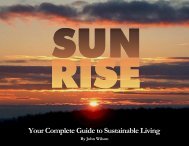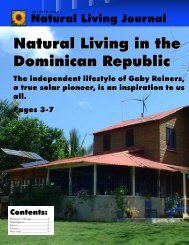Volume 3 - Program & Project Ideas (PDF - 4.5 - Natural Life Network
Volume 3 - Program & Project Ideas (PDF - 4.5 - Natural Life Network
Volume 3 - Program & Project Ideas (PDF - 4.5 - Natural Life Network
Create successful ePaper yourself
Turn your PDF publications into a flip-book with our unique Google optimized e-Paper software.
<strong>Natural</strong> Resources Canada – Community Energy Systems<br />
L.2.1.2 Demonstration initiatives<br />
- Case study: Truro, NS<br />
The Town of Truro, working with Farmington Development, built a community using<br />
alternative planning and development standards, and convertible house designs as a way<br />
of reducing housing costs. The demonstration project, known as the Farmington Village<br />
project, used several new regulations and standards, including: reduced lot size and<br />
setbacks, narrower street width, narrower right-of-way, combined servicing laterals to<br />
houses, and parkland dedications from 5 to 10 per cent (to retain more natural<br />
vegetation).<br />
• Less energy is used in the construction of roads and rights of ways because<br />
they are narrower than conventional streets.<br />
• The new, narrower road width has been adopted municipal-wide as part of the<br />
new plan review and update, creating further energy savings.<br />
• Conversion potential built into the houses to allow a secondary unit, facilitates<br />
intensification, reducing urban sprawl.<br />
• Smaller lots, reduce the purchasing and maintenance costs.<br />
• Combining servicing laterals to houses reduces the construction costs and<br />
energy associated with it.<br />
Source: ACT. Grant Award fact sheet. http://www.actprogram.com/english/projects/das2.asp For<br />
additional information, contact the City of Truro www.town.truro.ns.ca<br />
- Case study: Surrey, BC<br />
The University of British Columbia, working with the City of Surrey, developed planning<br />
principles, standards and bylaws to demonstrate a sustainable community development<br />
that may reduce housing costs by 30 per cent. The Headwaters <strong>Project</strong> or East Clayton<br />
project, as it is commonly referred to, is being built in Surrey, BC.<br />
• Compact and walkable neighbourhoods encourage pedestrian activities<br />
because the basic services (e.g., schools, parks, transit, shops, etc.) are within<br />
a five- to six- minute walk of people's homes, saving energy in car use.<br />
• Mixed-use commercial core (i.e., commercial-residential; live/ work and<br />
work/live; ground-oriented town homes), and street-oriented buildings<br />
encourage pedestrian-friendly and economically vibrant community nodes.<br />
• Trip generation per capita is reduced by 40 per cent because of the grid street<br />
pattern layout and others.<br />
• Narrow, curbless streets save money, allow natural water runoff and are more<br />
easily shaded by street trees, saving energy for cooling, and construction and<br />
maintenance of infrastructure.<br />
• Useable backyard space is increased because front yard setbacks are reduced<br />
and parking is accessed through back lanes.<br />
Draft 4/11/2005 49






